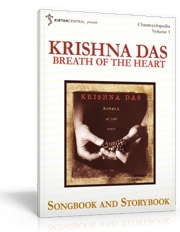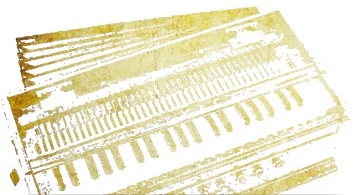



 |

Kirtan+ConfettiMusic and Mantra playlists |
 |

Learn harmonium!Online music classes |
 |

Krishna Das
|








 |

Kirtan+ConfettiMusic and Mantra playlists |
 |

Learn harmonium!Online music classes |
 |

Krishna Das
|

|
Are chords an authentic part of kirtan?
|
Either way, your ear imagines them playing chords on their harmoniums. Krishna Das adds characteristic ornaments between his chords, Jai Uttal often improvises within an Indian scale before moving to the chords, and many kirtan musicians add a bit of the melody interwoven with the chords. But the chords are still the foundation.
That said, kirtan in India... didn't have chords!
When I was first learning harmonium and realized this, it startled me, made me feel like the chord-based kirtans I was learning were inauthentic. Eventually I reconciled it as an important part of us westerners making kirtan our own - expressing our love of the divine names through the musical elements that are woven into our fabric through a lifetime of listening to (and perhaps playing) western chord-based musics.
Then I had an amazing experience. On my third trip to India, I sat with a Bengali kirtan wallah in Mayapur. He was teaching me traditional kirtan songs based on simplified ragas - very Indian style - and yet, as he demonstrated the songs, his right hand kept adding chords into the mix! As I listened to other Bengali kirtan wallahs, I would also occasionally hear chords tossed in, though the foundation was clearly melody.
In the 20th century, Western and Indian music began a love affair that affected all genres - American rockers like the Beatles added raga-scales and sitar sounds to their repertoire, sure, but equally Indian pop music producers picked up electric guitars, and Indian classical musicians adapted the use of saxophones and keyboards. And finally, kirtan musicians are using chords now! Not all the time, but as an added color in their palette.
|
|
[see permalink] |

|
Krishna Das Radio launches today
|
Channel 360, also called "Krishna Das Yoga Radio," is being warmly and personally introduced throughout the day today by Krishna Das himself, who has selected a wide range of chant and sacred music tracks to intersperse with the live kirtan tracks from his latest release, "Live Ananda." There will be Deva Premal, Jai Uttal, Wah!, and other modern western chant recording artists, as well as great sacred musicians of India such as the late Ali Akbar Khan and Pandit Jasraj.
For those of us already in love with chant music, it's no suprise that the genre is being embraced by wider and wider circles. Sirius XM Internet radio has many millions of listeners, and who better to introduce these listeners to the heart-opening promise of chant music than Krishna Das. Bravo, KD!
>See Krishna Das' email announcement here.
>Visit the Krishna Das Yoga Radio station's website here.
>And if you're like me, you'll need to get the free 30-day trial of Sirius here.
|
|
[see permalink] |

|
The Inner Harmonium (a visualization)
|
We're drawn to kirtan because it is heart-opening, but leading kirtan can have it's panicky pitfalls! Fortunately, this one is avoidable with a short practice.
The crucial ingredient is a stronger experience of the "inner harmonium," so that she doesn't have to hear "the outer harmonium" in order to know what she's playing. A trained musician will be able to imagine her instrument in her mind's eye, and imagine herself playing it, and literally hear the music internally.
To develop this skill, sit with your "external harmonium" in front of you.
> Play a note out loud on the physical harmonium while looking at the keyboard. Listen to the note.
> Repeat this, but now close your eyes and picture the keyboard while you physically play the note. Listen to the note.
> Lift your hand off the physical harmonium, so your hand is in the air. With eyes closed imagine your hand pressing that note on the keyboard. Press your physical finger in the air. Imagine you are hearing the note again.
> Put your hands by your side. Imagination only: visualize your hand on the keyboard, and "hear" the note.
If the visualized "inner harmonium" and it's music isn't clear at first, it's ok! Practice it a few minutes periodically, and after some weeks it'll be vivid as daylight.
Finally, if this exercise becomes easy, repeat the steps with a chord instead of a single note, or a short phrase or melody. Eventually, you'll be able to play entire songs on your "inner harmonium," and it will become a linked-up part of your musical imagination.
|
|
[see permalink] |

|
Exploring Harmonium video series
|
These videos are not comprehensive, not thorough, not even step-by-step! Leave that to the five hours of video lessons in the "Learn to Play Harmonium" kit.
These are two minutes each, presenting one crucial concept about playing kirtan on harmonium. One episode shows a new way to position "open chords" that can transform the sound of a kirtan. Another episode demonstrates how chords can be played in different rhythms to give the kirtan motion and energy, especially when there's no percussionist.
I hope they prove interesting to all you chantaholics working on getting your squeeze boxes rocking! It's always fun to have new musical techniques to play with, to beautify our musical prayers and to engage our full mind and heart in devotional musicking.
|
|
[see permalink] |

|
You give my life melody
|
I am exploring the minor pentatonic scale, making geometric patterns that ascend and descend across the entire range of the harmonium. I'm partway between doing scale exercises and free improvisation, and I'm finding it stimulating in a cerebral, mechanical way.
Then I hear your footsteps, and you enter the dimly lit room from behind me. Gently nearing, you tell me how you're enjoying hearing me play, and give me a kiss on the cheek. It's a small gesture, but as you turn and walk away I notice my playing has changed. I had continued the whole while, smiling and thanking you while my fingers kept meandering along the keyboard. And yet, now it is different - melody fragments are appearing, chord rhythms are coalescing. Song, if proto-song, is emerging.
I marvel at the unintended plunge into melodic creativity that your nearness inspires. Even in hard times, your nearness brings me into melody, the heart of music.
|
|
[see permalink] |

|
Acoustics of Harmonium Reeds part 2
|
For a saxophone, as with a clarinet, the reed is cut from cane and is rather soft and pliable. As a material, it exhibits no preference for one frequency of vibration over another, and so with just one reed on the saxophone's mouthpiece, a full range of notes can be played - from quite low to very high. As my fingers pressed the saxophone's keys, pads closed up holes in the long metal tube body, effectively changing the length of the resonating chamber. It was this length that determined the frequency of vibration (i.e. the pitch - the note), the pliable cane reed vibrating more or less quickly to keep pace with the more dominant tube-length attribute.
With a harmonium, this is not the case! Every single note on the harmonium's keyboard has a different reed beneath it. The size of the air chamber (the boxes of the harmonium) never changes. Instead, the reeds are cut to specific lengths (low notes are longer reeds, high notes are shorter reeds) and made of metal (usually brass) which expresses a strong preference for a specific vibrating frequency. Such reeds are suited for playing a specific note, and none other, which for a harmonium fits the bill perfectly - but would spell disaster for a saxophone.
And so I reach a new conclusion: A saxophone would never work with a metal reed, and a harmonium will never work with cane reeds.
|
|
[see permalink] |

|
Acoustics of Harmonium Reeds
|
Over the last few years, I have often found myself fussing over and pondering harmonium reeds. They are one of the more common parts in the Indian-made harmoniums to fail, usually by going out of alignment and causing a grating, metallic buzzing sound. They are also, however, the essential component that leads to the vibrant, reedy, sustained tone of the harmonium.
Other instruments, such as a guitar, cello or piano, rely on their wood selection and wood craftsmanship for their tone. For these instruments, a string initially produces the tone, but the string itself is quite thin and very quiet (think of strumming an electric guitar when the volume is off). And so these instruments have "sound boards" and "resonating chambers" built in to their design, to pick up the quiet string's note, and amplify it many fold.
For a harmonium, however, the wooden box is not a sound board, it is mostly a structural encasement for the inner parts, such as the hidden secondary bellows which expands to fill the lower half of the harmonium's box. For a harmonium, it's the reeds that determine its tone, in combination with the small channel the reed plays through, hidden at the back of each key on the keyboard.
Last week, I took apart an old Hohner harmonica (harmonicas, along with accordions, are the closest living relatives of the harmonium), in hopes of gaining new insights about how to improve harmonium reeds. Then I stumbled on to a community of custom harmonica builders, who helped me understand two critical aspects of the acoustics of vibrating musical reeds:
First, the metal reed must be situated in its reed box (the small, sturdy brass rectangle around the reed) with the smallest possible tolerances. The harmonica customizers were praising one reed maker who brought the tolerances down to .0005" (a tiny fraction of an inch), made possible by advanced computer-aided machining techniques. With that tiny a gap around the reed, very little air is being lost. This not only makes the bellows generally more efficient, but more critically, gets the reed vibrating quicker. This is called "responsiveness," and it's a thing I've noticed severely lacking in many Indian-made harmoniums. Before now I've never understood what caused it - even after all leaks in the bellows and boxes are cured, such harmoniums still aren't very responsive. You press a key down, and it takes a half a second before sound is coming out. What I can see now (physically see - open up a harmonium and you'll see plenty of light shining between the reeds and their reed boxes) is that when reeds aren't made with fine tolerances with regard to their reed boxes, responsiveness goes downhill.
Second, the type of metal and thickness profile of the reed must make it as close to "ideal" a spring as possible. An "ideal" spring oscillates with a "simple harmonic motion." Such a vibrating object has a unique property that suits it for music making - namely, that no matter how much force it is played with (i.e. loud or soft), its frequency is the same. Interestingly, this is not true for most physical objects. Can you imagine playing a middle C on the piano... and playing it harder, it goes a bit flat, and playing really hard it goes very flat? Gosh that would be awful, and thankfully not the case - piano strings vibrate rather ideally, maintaining their pitch at all volumes. Unfortunately, that's not the case with the current state of harmonium reed design. When you play your harmonium softly, the reed is a bit sharp. Play it at a "normal" volume and it is as "in tune" as that particular harmonium can be. Play it loud, however, and the pitch (the frequency of vibrations) drops, causing the note to go flat.
My guess is that since harmonium reed-making technology got to India more than a century ago, the craftsmanship and purity of metal required have both been in decline. Today, it's hard to get harmonium reeds from the Indian makers that are in tune to begin with, but even those that are in tune have this frustrating property of going rather flat when played loudly. I wonder how much this could be mitigated by more precise thickness-profiles and better metal purity.
|
|
[see permalink] |

|
Can I play Beatles on my Harmonium?
|
My response?
Absolutely!
We have this funny notion that the harmonium is an Indian instrument, but actually it was born in Paris! It had a nineteenth century heyday throughout Europe and the US, and was brought to India as a portable church organ by the British, where it has continued to flourish.
The harmonium is a remarkably versatile instrument, and musicians of many backgrounds have embraced it. At various points over the last two hundred years, the harmonium has been prominently featured in Christian churches, Sufi mosques, Hindu mandirs, and Sikh gurdwaras.
And since recorded music began, many eclectic musicians have used it as a non-traditional color to paint with: George Harrison turned the Beatles on to harmonium, which they played on many of their later more spiritual tracks (easy to hear on "The Inner Light"). Other modern artists to use harmonium in live shows or on their albums include Tori Amos, Jeff Buckley, Pink Floyd, Radiohead, Sigur Ros, and Tom Waits.
Some of these artists discovered the harmonium through their interest in Indian spirituality, others simply through their European heritage. I've met many second generation European immigrants here in the US who recall having a "squeeze box with pedals" (the old form of harmonium) in their childhood home in the old world.
And so my answer to the original question is Yes - absolutely! The harmonium can play the same chords as any piano or guitar, so whether you like the Beatles or Jack Johnson, Lady Gaga or Bob Dylan, you can google the chords to their songs and try it out on harmonium.
|
|
[see permalink] |

|
Festivals for Chantaholics
|
Bhakti Fest - A sprawling bi-annual gathering of the Bhakti tribe in Joshual Tree, California. Features multiple days of non-stop kirtan led by Jai Uttal, Krishna Das, the Mayapuris, Wah!, and dozens of other well-known and up-and-coming kirtan musicians. Called the "Woodstock of Kirtan."
Sat Nam Fest - This bi-annual Kundalini Yoga and Kirtan festival is put on by the inspired organization Spirit Voyage, and features top Sikh kirtan musicians: Snatam Kaur, Gurmukh, GuruGanesha Singh, Mirabai Ceiba, and many others.
Wanderlust - This yoga mega-fest happens in beautiful outdoor locations around the country, including Vermont, California and Colorado. Many of the yoga classes during the day are accompanied by sacred music, and the evenings are filled with top kirtan musicians as well as rock bands.
Festival of the Holy Name - This ecstatic celebration of the Hare Krishna Maha Mantra is held annually in Alachua Florida. Featuring non-stop kirtan led by a rotation of the top musicians in the Hare Krishna community, including the Mayapuris, Ananta Cuffee, Bada Haridas and many others.
Omega Ecstatic Chant Weekend - Held annually at Omega's main campus in Rhinebeck, New York, this is one of the oldest American kirtan festivals coming up on it's seventh year. Many top kirtan artists from all traditions are featured: Krishna Das, Deva Premal and Miten, Jai Uttal, Donna De Lory, Dave Stringer, Radhanath Swami, The Mayapuris, C.C. White, and lots more, interspersed with yoga and meditation sessions.
Beloved - This four-day camping, art, and music fest on the Oregon coast casts a wider net than just kirtan, but includes in it's musical line-up Jai Uttal and Shimshai, as well as the renowned Sufi Qawwali ensemble Fanna Fi Allah.
Tadasana Festival - A new three-day yoga, music, community gathering in Santa Monica, California in celebration of earth day 2012.
|
|
[see permalink] |
Copyright 2010-2012 Daniel Tucker